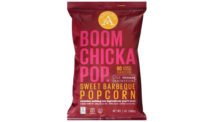Frozen pizza, as well as frozen pizza crusts and dough, had an improved year from a sales perspective over the past 52 weeks in the wake of strong—and continued—product and category innovation. And this innovation is resonating with shoppers at a key time in the evolution of pizza across both retail and foodservice, with encouraging growth of fast-casual pizza and intensified cross-market competition.
Overview | Bread | Tortillas | Sweet Goods | Snack Cakes | Pizza | Desserts | Cookies | Buns & Rolls | Bars | Breakfast Products
Clearly, the market is hungry for pizza creativity as we appear on the cusp of a pizza renaissance, with strong development of enticing products that appeal to strategic pizza demographics like millennials, and those following a gluten-free diet, as we raise the bar for pizza quality across the board.
Market data
For the 52 weeks ending April 17, 2016, frozen pizza saw dollar sales grow 3.03 percent, per IRI, Chicago—a better year than last time around—representing dollar sales of $4.7 billion. And the frozen pizza crusts/dough segment grew to $20.2 million, with dollar sales up 21.94 percent, illustrating a growing shopper demographic interested in speed-scratch pizza creation at home—along with a strong gluten-free market.
In frozen pizza, private label saw dollar sales growth of 14.54 percent, and Home Run Inn was up 12.17 percent. But the real star was Palermo Villa, up 74.59 percent in dollar sales to $125.1 million. Its Screamin’ Sicilian line was up 326.25 percent in dollar sales for the year.
In our 2015 State of the Industry report for pizza, dollar sales were down by 1.39 percent. So growth of 21.94 percent for the 52 weeks ending April 17, 2016 is a dramatic turnaround. This growth is largely attributed to sales of private label frozen pizza crusts or dough, which grew by 303.04 percent in dollar sales to $4.4 million, as well as sales of Rich Products Corp. crusts and dough, up 270.52 percent to $1.8 million.
And in foodservice, as Technomic, Chicago, notes in its 2016 “Pizza Consumer Trend Report,” pizza consumption is increasing, with people now averaging 4.0 pizza occasions per month, up from 3.4 in 2014.
Looking back
Palermo Villa attributes its growth over the past 52 weeks to a rising shopper desire for high-end frozen pizzas. “In what has generally been a flat category the past few years, the upper price segments have grown substantially,” says Mike Pytlinski, senior brand director, Palermo Villa Inc., Milwaukee, WI. “In the past year, the emerging super premium segment—over $7 per unit—is up 86 percent, reflecting the growth of recent new products like Screamin’ Sicilian. We’re seeing where consumers are willing to pay a premium for frozen pizzas that are truly much closer to what they get from higher-end pizzerias.”
The Screamin’ Sicilian line from Palermo Villa includes Bessie’s Revenge (cheese), Boss Hog (Italian sausage), Spicy Clucker (jalapeño, chicken and bacon with ranch sauce), Holy Pepperoni (pepperoni) Mambo Italiano (pepperoni and meatballs), Supremus Maximus (pepperoni, Italian sausage, fire-roasted onions and bell peppers, and black olives), and Three Li’l Piggies (sausage, pulled pork, bacon with barbecue sauce).
“Screamin’ Sicilian is the fastest-growing brand in the category the past year, having tripled consumption and grown by 1.2 share points in the past year,” says Pytlinski. He notes that consumers of the brand have provided very positive feedback via social media, including sentiments that Screamin’ Sicilian is ”very close to pizzeria quality.”
While the Screamin’ Sicilian has a thicker crust, Pytlinski notes that thin and crispy crusts remain the leading crust type. So the company combined those two dynamics in a new super premium thin line.
“We’re now expanding this super premium platform with the March launch of Urban Pie, a flaky, thin-crust pizza featuring a fusion of contemporary flavors,” says Pytlinski. “Many consumers, especially millennials, are craving higher-end, but approachable, flavors—like they get in their favorite restaurants. Urban Pie brings that ‘approachable sophistication’ to frozen pizza with unique flavor combinations. Our retail partners are craving products like Urban Pie that directly appeal to millennials. The North End variety, named for the famous Boston neighborhood, is a mushroom pizza, but rather than button mushrooms, it features shiitake and crimini mushrooms combined with truffle Alfredo, rosemary, capers and caramelized onions.”
Other pizzas in the Urban Pie line include Lakeview (sun-dried tomato, chicken sausage, fire-roasted yellow pepper, spinach and sun-dried tomato sauce), Little Italy (fresh mozzarella, cherry tomato, basil and pesto sauce) and Mission District (uncured pepperoni, chicken sausage, tomatoes, basil, green peppers, onions, crimini mushrooms and roasted red bell pepper sauce). “These are all flavors consumers are used to ordering—just not on a frozen pizza,” says Pytlinski.
According to Technomic’s “Pizza Consumer Trend Report,” 39 percent of consumers say that new and unique pizza toppings are highly important in creating a good pizza; that number is up from 32 percent in 2014.
The top company in frozen pizza crusts/dough is Boulder Brands, which owns the Udi’s Gluten-Free Foods brand. Udi’s pizza crusts were up 7.41 for the 52 weeks ending April 17 to $5.6 million, per IRI. Packaging for the crusts clearly notes that they are also free of dairy, soy and nuts.
Against the Grain Gourmet saw growth of 18.45 percent in dollar sales in the frozen pizza crusts/dough segment for its gluten-free pizza shells, which build appeal by baking Cheddar, mozzarella and Parmesan cheeses directly in the dough.
Rich Products Corp., at the No. 3 spot in frozen pizza crusts/dough for the past year, has a long maintained a strong focus on pizza. The company first diversified into gluten-free pizza crust in 2009 and delivers the par-baked crusts to foodservice customers in ovenable aluminum pans to help minimize cross-contamination. The company also offers artisan-style frozen dough balls to its foodservice customers.
Rich Products supplies both retail and foodservice, and can cross-pollinate ideas to drive sales as pizza grows more competitive. One recent product launch, its Della Suprema line of thin and crispy take-and-bake retail flatbread pizzas, is designed to entice shoppers who typically would visit a pizzeria to save a few bucks and bake their own pies at home. The line includes Spicy Chicken Sausage (spicy chicken sausage, roasted red and green peppers, caramelized onion, garlic, Parmesan, asiago and aribbata sauce), Spinach & Mushroom (roasted mushrooms, spinach, asiago and lemon béchamel sauce) and Tuscan Chicken (chicken, garlic, caramelized onion, chopped spinach, roasted mushrooms, basil, pepper flakes, Provolone, Parmesan, Romano and lemon béchamel sauce).
Looking forward
Technomic’s 2015 “Top 500 Chain Restaurant Report” notes that three of the top-five fastest-growing chains during 2015 were fast-casual pizza chains Blaze Pizza, up 205 percent over the previous year; Mod Pizza, up 131 percent; and Pieoogy Pizzeria, up 67 percent. These foodservice concepts are bringing new levels of ingredient intrigue to a wider audience by virtue of their rapid expansion.
While standard pies are part of the core offerings at both chains, the core menu of Blaze includes options like Green Stripe (grilled chicken, roasted red peppers, garlic and arugula with a pesto drizzle) and Art Lover (artichokes, ricotta and garlic), while Mod offers Tristan (asiago, roasted red peppers, mushrooms and pesto) and Calexico (gorgonzola, chicken, jalapeños and buffalo sauce). Pieology’s menu includes Alfredo’s Alfredo (olive oil, Alfredo sauce, Parmesan, garlic, mushrooms, artichokes, basil, grape tomatoes and black pepper) and Rustic Veggie (whole wheat crust, olive oil, ricotta, green peppers, roasted red peppers, red onion, corn, garlic and basil).
The rise of limited-service and fast-casual restaurant pizza has brought new levels of competition for the pizza industry—but also inspiration to drive the frozen retail category forward. “Higher end, fast-casual pizzerias doubled in the past year, and are expected to do so again this year,” says Pytlinski. “Many of these restaurants feature unique combinations of contemporary ingredients. Progressive retailers need to smartly incorporate these learnings into frozen pizzas, while maintaining a balance with the traditional flavors and toppings.”
Bob Grote, CEO, Grote Co., Columbus, OH, points toward millennials as catalysts for growth. “Natural products, non-GMO and hormone-free products, as well as unique combinations, can all drive interest—primarily from the millennial generation,” he says. He says spicy, ethnic flavors often entice this demographic.
According to the 2015 “Retailer Meal Solutions Consumer Trend Report” from Technomic, 44 percent of all consumers—and 56 percent of millennials—are searching for more prepared foods at retail that feature ethnic flavors and ingredients.
Strong levels of innovation brought success to several companies working in pizza over the past year, but intensified R&D, with a close eye on consumer preferences across both retail and foodservice, must continue in order to usher in continued incremental growth in the category.
Overview | Bread | Tortillas | Sweet Goods | Snack Cakes | Pizza | Desserts | Cookies | Buns & Rolls | Bars | Breakfast Products











